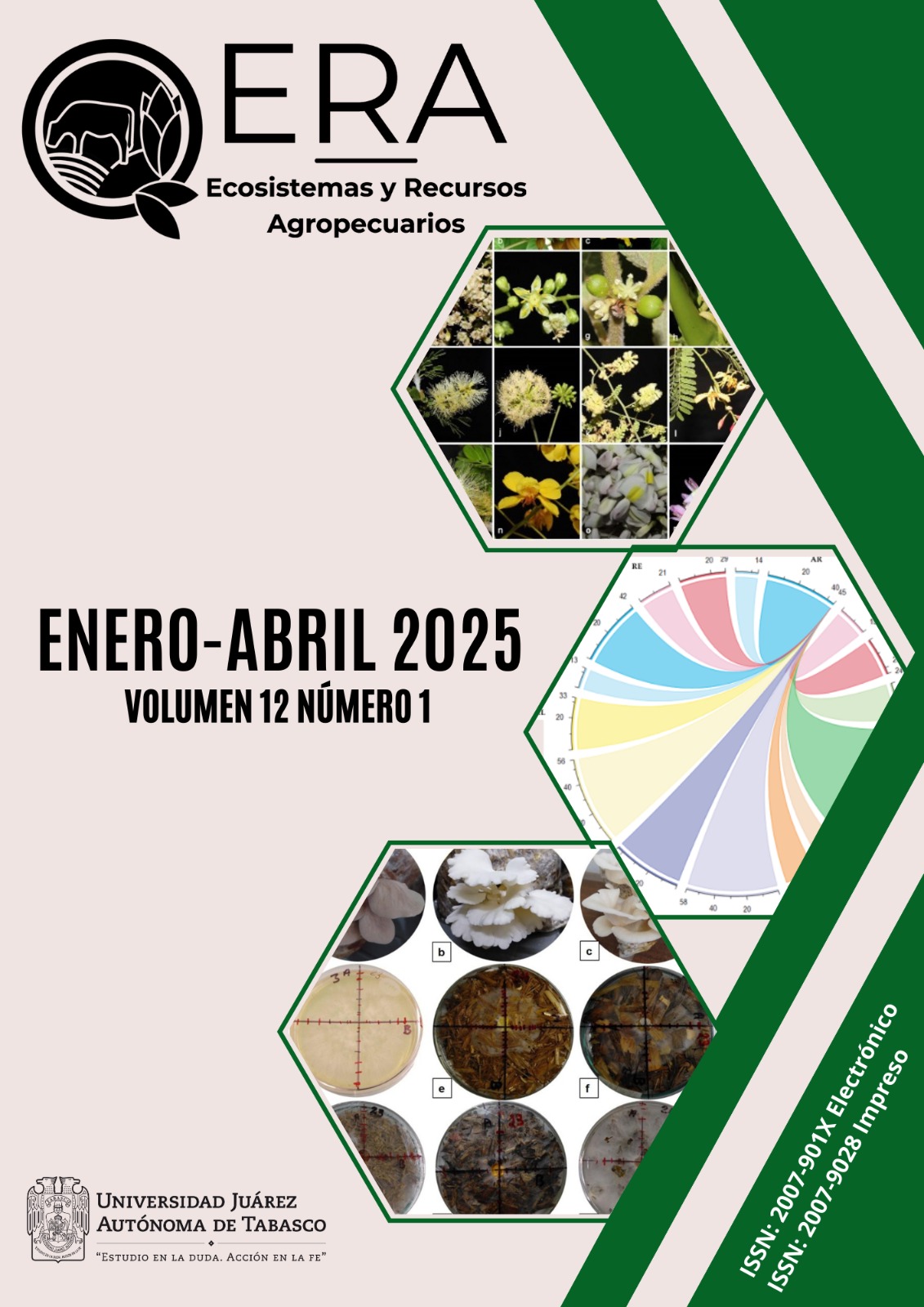Reliability and concordance of Schaeffer and Agarwal formulae for predicting crossbred dairy cattle weight
DOI:
https://doi.org/10.19136/era.a12n1.4245Keywords:
Liveweight, biometric measures, heifers, tropicsAbstract
The study was aimed to evaluate the reliability and concordance of the Schaeffer and Agarwal formulae for predicting body weight in Gyr (Holstein×Cebu) crossbred cows and heifers. Body weight (BW), heart girth (HG) and body length (BL) were recorded in 156 cows and 98 heifers. There was a strong positive correlation (p < 0.0001) between BW observed and BW predicted using the Schaeffer and Agarwal formulae (r ≥ 0.96 ≤ 0.97). Although reliability and agreement were low, as indicated by the CCC values, they were higher for the Agarwal formula. The results suggest that BW predictions using the Agarwal formula are preferable to those using the Schaeffer formula. The results suggest that Agarwal's formula may be useful for estimating BW in crossbred cattle kept under humid tropical conditions in southeastern Mexico.
Downloads
References
Bretschneider G, Cuatrin A, Arias D, Vottero D (2014) Estimation of body weight by an indirect measurement method in developing replacement Holstein heifers raised on pasture. Archivos de Medicina Veterinaria 46: 439-443. http://dx.doi.org/10.4067/S0301-732X2014000300014
Colorado-García P, Ponce-Covarrubias JL, Barrientos-Medina RC, Zaragoza-Vera CV, Zaragoza-Vera M, Torres-Chable M, Chay-Canul AJ (2024) The Schaffer formula can’t predict liveweight in Black Belly sheep. Tropical and Subtropical Agroecosystems 27: 145. http://doi.org/10.56369/tsaes.5646
Dingwell RT, Wallace MM, McLaren CJ, Leslie CF, Leslie KE (2006) An evaluation of two indirect methods of estimating body weight in Holstein calves and heifers. Journal of Dairy Science 89: 3992-3998. https://doi.org/10.3168/jds.S0022-0302(06)72442-0
Fox J, Weisberg S (2018) An R companion to applied regression. 3rd ed. SAGE Publications, Inc. Thousand Oaks, CA, USA. 608p.
Franco MO, Marcondes MI, Campos JMS, Freitas DR, Detmann E, Valadares-Filho SC (2017) Evaluation of body weight prediction equations in growing heifers. Acta Scientiarum Animal Sciences 39: 201-206. https://doi.org/10.4025/actascianimsci.v39i2.33118
Heinrichs AJ, Rogers GW, Cooper JB (1992) Predicting body weight and wither height in Holstein heifers using body measurements. Journal of Dairy Science 75: 3576-3581. https://doi.org/10.3168/jds.S0022-0302(92)78134-X.
Herrera-López S, García-Herrera R, Chay-Canul AJ, González-Ronquillo M, Macías-Cruz U, Díaz-Echeverría VF, Casanova-Lugo F, Piñeiro-Vázquez A (2018) Desarrollo y evaluación de una ecuación para predecir el peso vivo en novillas cruzadas usando el ancho de cadera. Información Técnica Económica Agraria 114(4): 368-377. https://doi.org/10.12706/itea.2018.022
Lesosky M, Dumas S, Conradie I, Handel IG, Jennings A, Thumbi S, Toye F, Bronsvoort BMC (2012) A live weight–heart girth relationship for accurate dosing of east African shorthorn zebu cattle. Tropical Animal Health and Production 45: 311-316. https://doi.org/10.1007/s11250-012-0220-3
Lin L (1989) A concordance correlation coefficient to evaluate reproducibility. Biometrics 45: 255-268. https://doi.org/org/10.2307/2532051
Lin L (2000) A note on the concordance correlation coefficient. Biometrics 56: 324 - 325. https://doi.org/10.1177/1536867X0200200
Lukuyu MN, Gibson JP, Savage DB, Duncan AJ, Mujibi FDN, Okeyo AM (2016) Use of body linear measurements to estimate liveweight of crossbred dairy cattle in smallholder farms in Kenya. SpringerPlus 5: 63. https://doi.org/10.1186/s40064-016-1698-3
Mota DA, Berchielli TT, Canesin RC, Rosa BL, Ribeiro AF, Brandt HV (2013) Nutrient intake, productive performance and body measurements of dairy heifers fed with different sources of protein. Acta Scientiarum. Animal Sciences 35(3): 273-279. https://doi.org/10.4025/actascianimsci.v35i3.18749
Navarro KLM, Yostar EJ, Romero MSI, Smahlij JM, Ondo MLM, Revidatti MA, Capellari A (2023) Predicción del peso corporal en biotipos del nordeste argentino. Actas Iberoamericanas de Conservación Animal 18: 28-30.
Oliveira AS, Abreu DC, Fonseca MA, Antoniassi PMB (2013) Short communication: Development and evaluation of predictive models of body weight for crossbred Holstein-Zebu dairy heifers. Journal of Dairy Science 96: 6697-6702. https://doi.org/10.3168/jds.2013-6988
R Core Team (2024) R: A Language and Environment for Statistical Computing. R Foundation for Statistical Computing, Vienna, Austria. https://www.R-project.org/. Data consulted: June 06, 2024.
Reis GL, Albuquerque FHMAR, Valente BD, Martins GA, Teodoro RL, Ferreira MBD, Madalena FE (2008) Predição do peso vivo a partir de medidas corporais em animais mestiços Holandês/Gir. Ciência Rural 38: 778-783. https://doi.org/10.1590/S0103-84782008000300029
Tebug SF, Missohou A, Sabi SS, Juga J, Poole EJ, Tapio M, Marshall K (2016) Using body measurements to estimate live weight of dairy cattle in low-input systems in Senegal. Journal of Applied Animal Research. https://doi.org/10.1080/09712119.2016.1262265
Wangchuk K, Wangdi J, Mindu M (2018) Comparison and reliability of techniques to estimate live cattle body weight, Journal of Applied Animal Research 46(1): 349-352. https://doi.org/10.1080/09712119.2017.1302876
Wood S, Reyher KK, Barrett DC (2015) Comparison of visual assessment and heart girth tape measurement for estimating the weight of cattle in clinical practice. Veterinary Journal 203: 337-338. https://doi.org/10.1016/j.tvjl.2014.12.034
Published
Issue
Section
License
Copyright (c) 2025 Ecosistemas y Recursos Agropecuarios

This work is licensed under a Creative Commons Attribution-NonCommercial-NoDerivatives 4.0 International License.
Aviso de copyright
Los autores que se envían a esta revista aceptan los siguientes términos:
una. Los autores conservan los derechos de autor y garantizan a la revista el derecho a ser la primera publicación del trabajo con una licencia de atribución de Creative Commons que permite a otros compartir el trabajo con un reconocimiento de la autoría del trabajo y la publicación inicial en esta revista.
B. Los autores pueden establecer acuerdos complementarios separados para la distribución no exclusiva de la versión del trabajo publicado en la revista (por ejemplo, en un repositorio institucional o publicarlo en un libro), con un reconocimiento de su publicación inicial en esta revista.
C. Se permite y se anima a los autores a difundir su trabajo electrónicamente (por ejemplo, en repositorios institucionales o en su propio sitio web) antes y durante el proceso de envío, ya que puede conducir a intercambios productivos, así como a una cita más temprana y más extensa del trabajo publicado. (Consulte El efecto del acceso abierto).


